After 2020 threw everyone a curveball, it might seem counterintuitive to plan communication on a yearly basis. After all, given the unexpected events that happened in the past year alone, how could one plan anything, let alone create an annual communications plan?
? Read Digital PR Explained: Best Strategies and Tools
Well, it’s not as irrational as it might seem. Having an annual communications plan set in place will prepare your business to successfully manage any potential obstacle or crisis. It helps you identify messages you need to communicate, to whom you need to communicate them, and what channels to use while doing so.
As such, an annual communications plan also ensures that you work on your goals and follow through with your strategy.
To make this whole process easier for you, we’ve defined every step and every element of a communications plan and provided:
- a fillable template to help guide you along,
- advice on how to use media monitoring as an additional tool in planning and executing your communications strategy.
As such, the annual communications plan consists of 5 parts:
Executive summary
The executive summary is a brief overview of your annual communications plan. The main purpose is to sum up all the important points so they’re viewable and understandable at one glance.
Not everyone from your company will need to read the complete document (and executives may not have the time to do so), so it’s important to list all the key things that will pertain to the year ahead. Most commonly, these include:
• Important dates, anniversaries, and milestones
• Projects and initiatives
• Mission and vision statements
• Main objectives and organizational goals
Although the executive summary is the first part of an annual communications plan, it should be written last. The reason for this is simple. Once you’ve completed your annual communications plan following the steps outlined in our template, it will be much easier to summarize everything.
About your organization
In this part, you should establish all key information about your organization to help you get an overview of resources you have at your disposal.
First up is the company overview.
Company overview
Write a list of key information related to your organization. For instance, what you do and where are you located. This will give an objective reader an introduction to your background story and ensure a deeper understanding of who you are as a company.
Company mission & vision statement
Mission and vision indicate a general direction in which the company wishes to go. It’s important to keep an eye on how the public perceives your vision and mission, to make sure you are on the right track.
MEDIA MONITORING ADVICE
To get these kinds of insights, you can use media monitoring. Let’s use Nike as an example. Nike’s mission statement is:
Bring inspiration and innovation to every athlete in the world.
Using our own media monitoring tool, Determ, we’ve tracked Nike mentions alongside these 3 main keywords relating to Nike’s mission: inspiration, innovation, athlete.
This sort of query setup can give you insights into how often certain keywords are connected to your brand online. And according to our search results, people actually do often mention Nike in the context of those three keywords (inspiration, innovation, athlete).
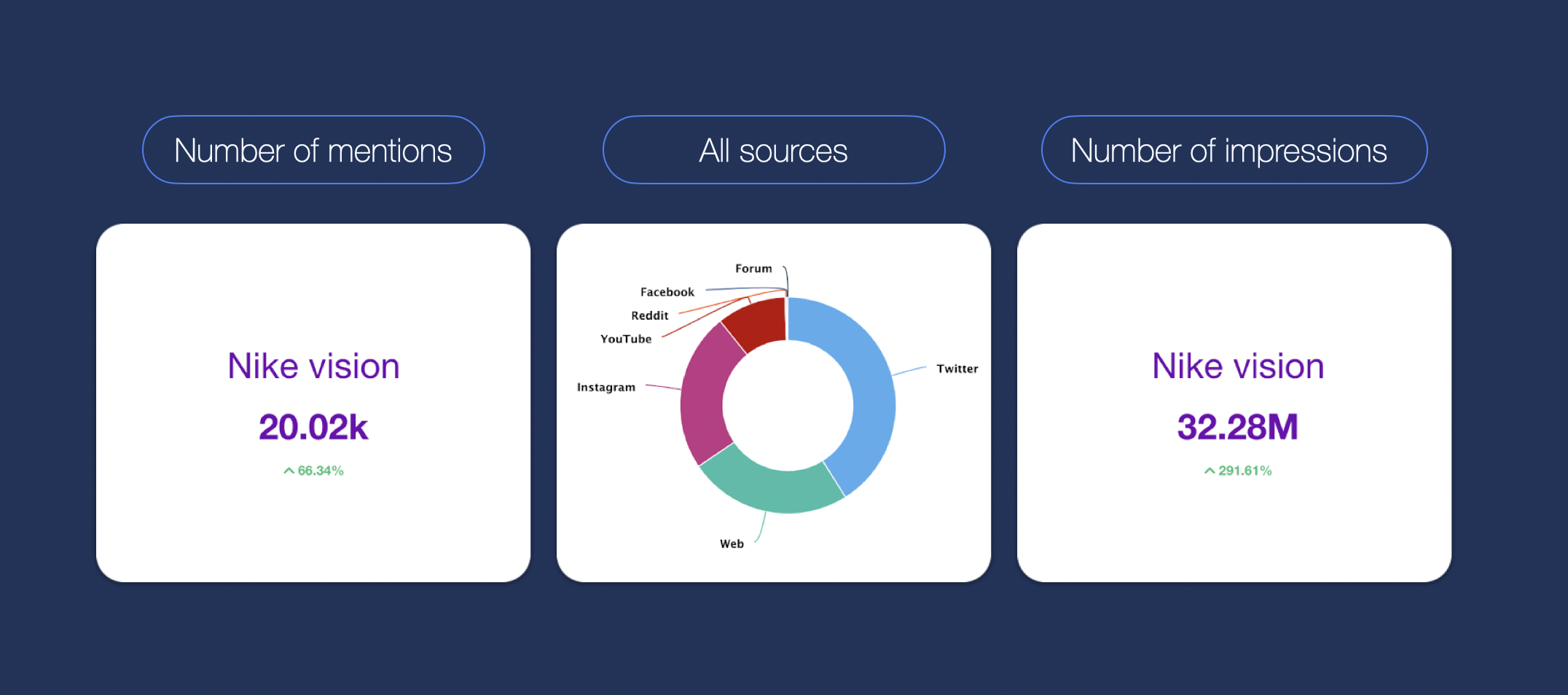
The sentiment of these mentions is also very positive, which means that those three values are well perceived in the public and are having a positive impact on Nike’s brand reputation.
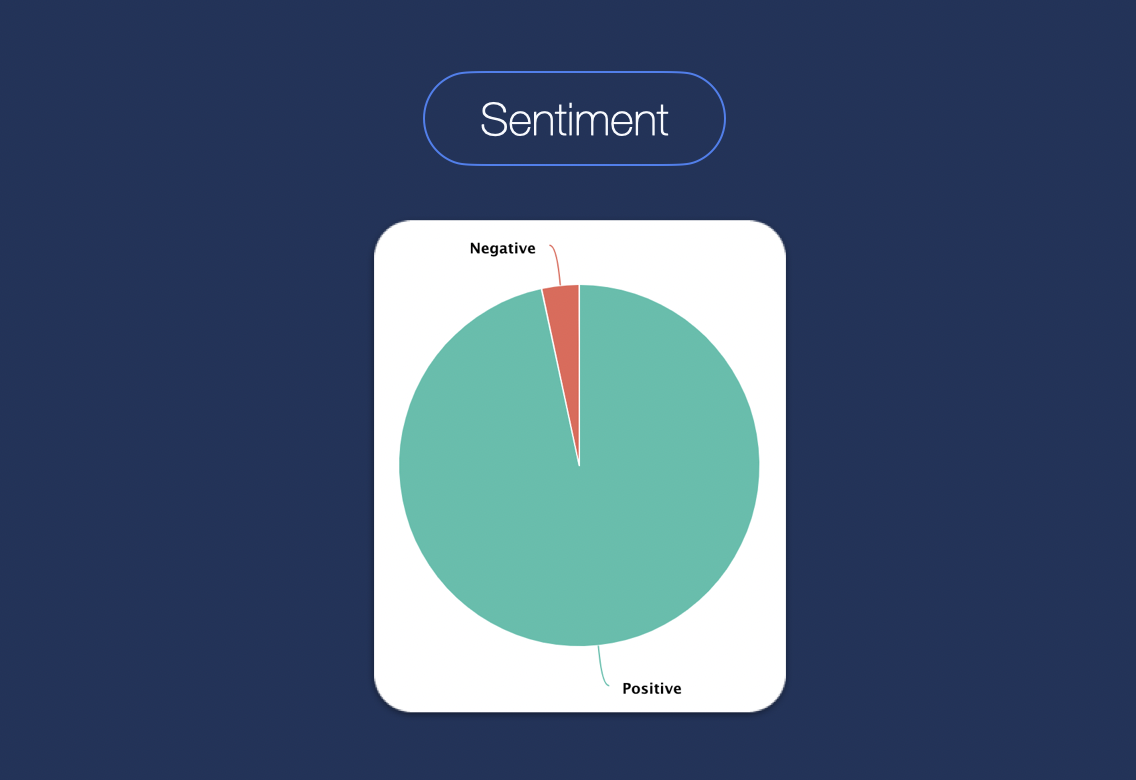
Organizational goals
Organizational goals stem from the organization’s mission. They indicate the general direction in which the organization wants to go.
When it comes to listing all the goals a company has, ask yourself these questions:
- How do your goals relate to the organization’s mission?
- Do they reflect the desired direction your organization wishes to go in?
- What difference will achieving these goals make?
Include as many colleagues as possible in this process. Listen to the ideas and goals they have in mind. After all, there’s no one better to define your organization’s goals than the very people working there. They know all the intricate details of your business, all the ups and downs, and all the potential that lies ahead.
Products & services
List all the product and/or services your organization offers. Define the value they provide for your customers and how they solve their problems.
When it comes to this part of the plan, we also suggest analysing the way your customers perceive your product, especially online. Knowing the reputation of your products and services is extremely important.
MEDIA MONITORING ADVICE
By tracking your products’ names (and other relevant keywords) with a media monitoring tool, you can discover how people talk about them. Not only will you get a general overview of the number of mentions, sentiment, or channels they use most often, but you will also get a unique insight into what your customers think about your products.
You may discover new opportunities by way of product improvements or new product ideas. Every complaint, every suggestion, every question can be turned into a key point of your communications plan for that year.
PESO model
The PESO model is an integrated strategic communications model that is comprised of paid, earned, shared, and owned media. It is a useful tool for planning how an organization uses different forms of media but the best thing about it is that it enhances the strengths and weaknesses of each channel in terms of trust, scale, cost, and predictability.
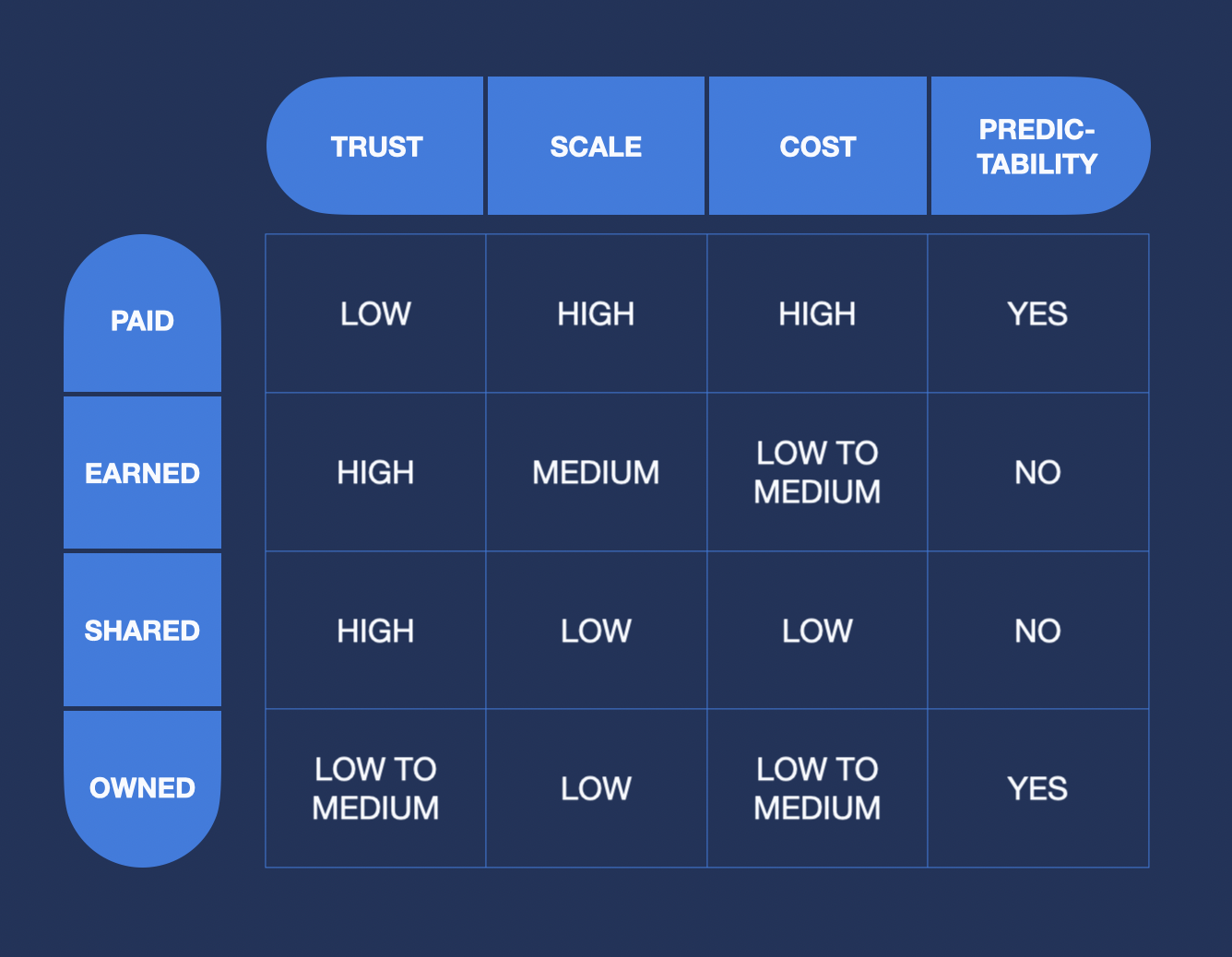
MEDIA MONITORING ADVICE
You can do PESO analysis through a media monitoring tool as well. By segmenting the sources into 4 different queries, you can separately track your media outlets according to PESO. You might detect that your owned outlets are generating more organic reach than the paid ones, which will be a good indicator of where to focus your efforts and money.
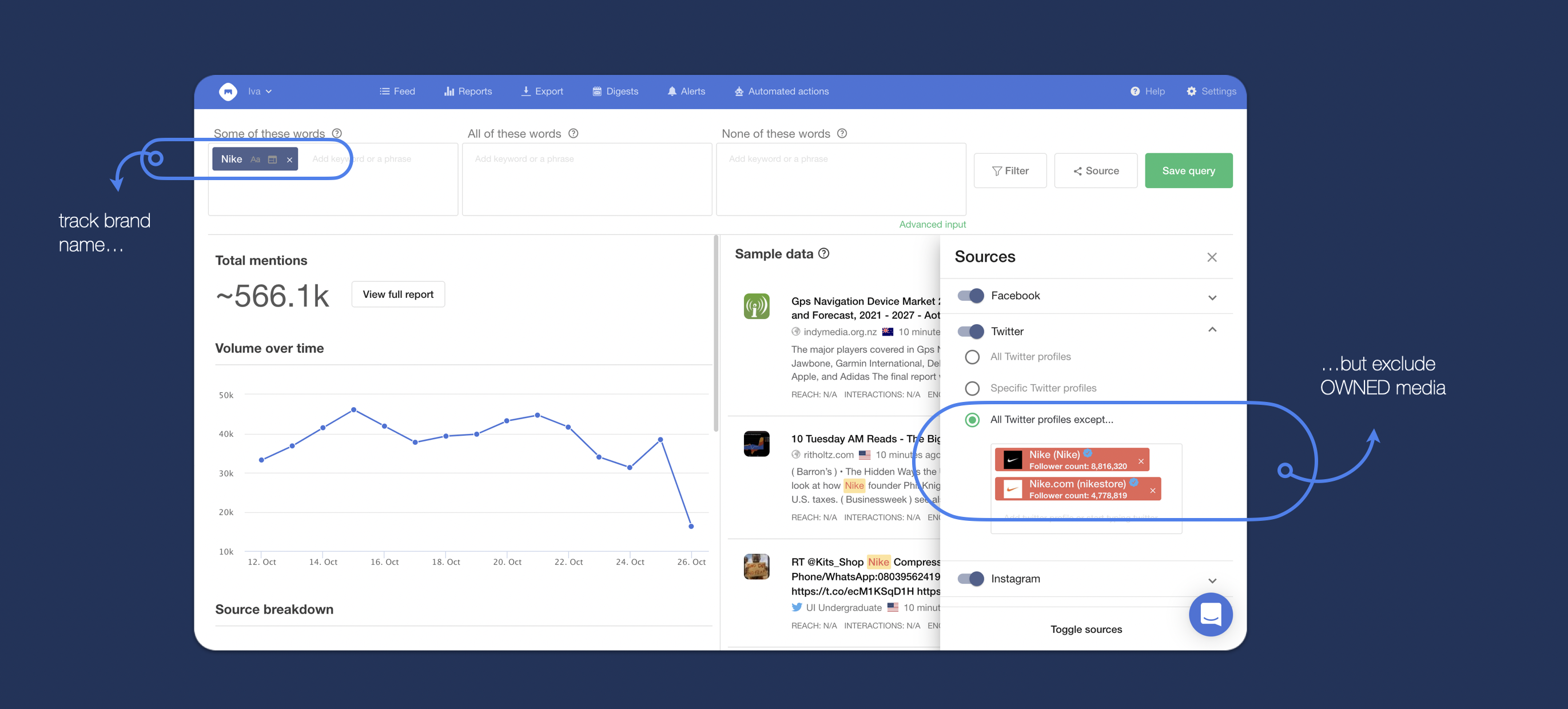
Communications team
This is a list of people responsible for executing your communications plan. Make sure to list all of their responsibilities, so every team member is aligned with the expectations and obligations.
Communications budget
You’ll need to answer these two questions:
- What is your budget for communications efforts that year?
- How and where do you plan to spend the budget?
At this point in the plan, you’ve done a PESO analysis so you’ll know exactly where and how to spend your budget.
Market analysis
Market analysis is a crucial part of an annual communications plan. It looks into the various aspects of your specific market and industry in general, allowing you to assess its current state, predict future trends, and keep up with the competitive landscape.
Industry overview
Describe the current state of the industry: industry trends, changes that have happened or are happening right now, new opportunities or potential threats.
MEDIA MONITORING ADVICE
You can track both trends and opportunities through media monitoring. By listening to what is being said online, it will be much easier to detect the needs and desires of your clients, plan the strategy accordingly, and gain success in the long run.
The Word Cloud chart especially can come in handy here as it shows the topics (keywords) that are mentioned most in the context of your company, brand, or strategy. It gives you a bigger picture which might shift your plans in a direction you couldn’t imagine before.
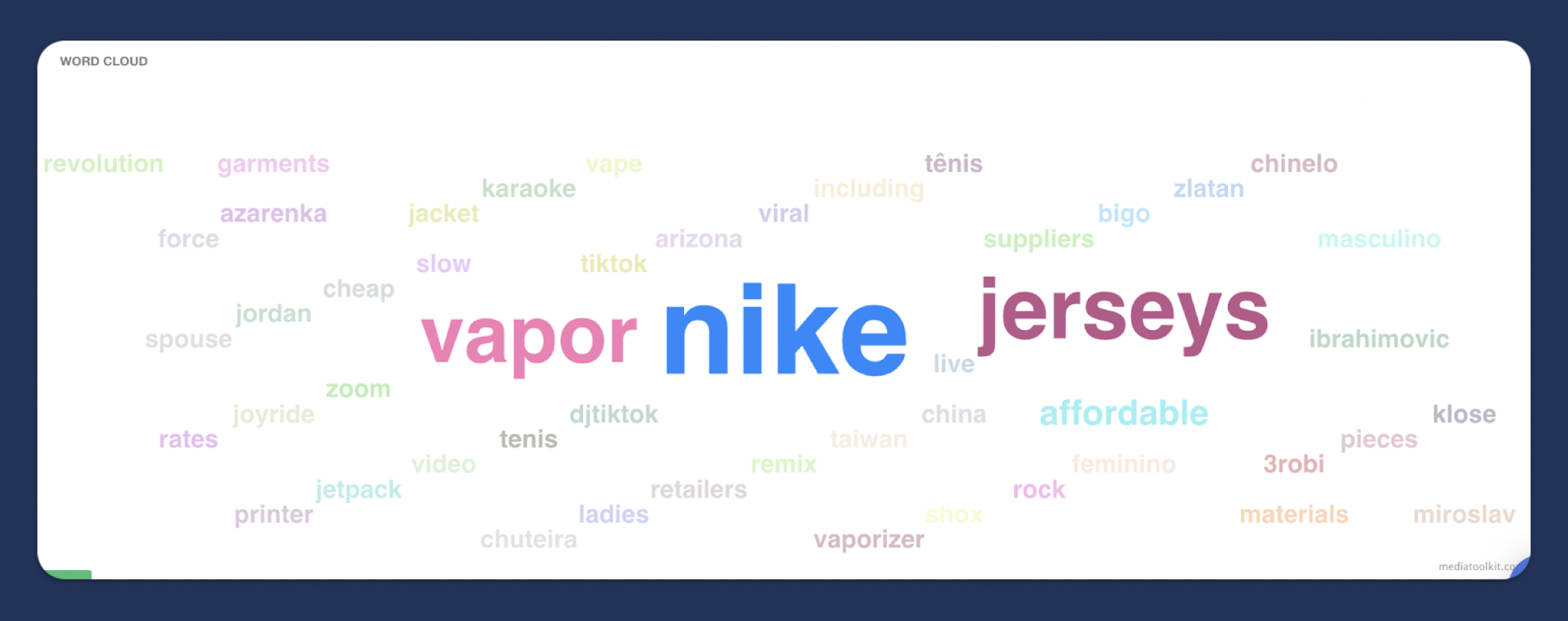
Positioning
Positioning your brand in the market means answering one main question: where do you stand in comparison to your competitors?
How makes you unique and separates you from the competition? What metrics do you use to to compare yourself to the competitors? Are you benchmarking on a local, national, or international level? These are all the questions you need to answer.
MEDIA MONITORING ADVICE
For instance, the share of voice metric can be an extremely helpful starting point. It shows the share percentage of the total number of online mentions between you and your competitors:
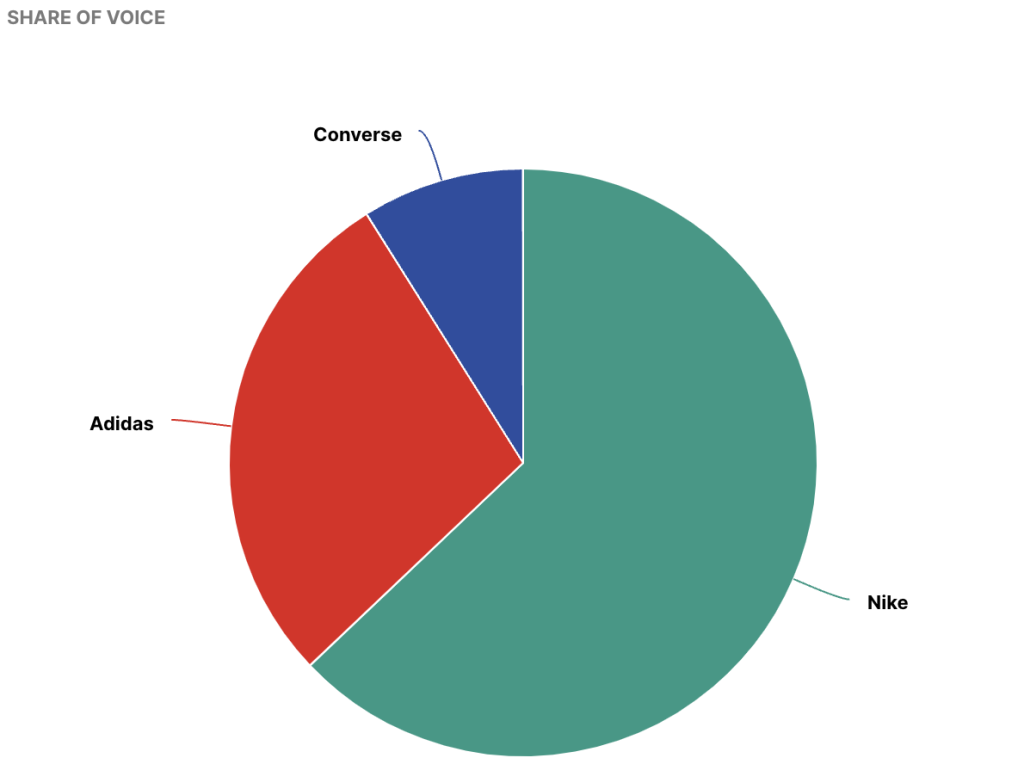
This way you can immediately know how you stand in the so-called popularity contest. However, before you make hasty conclusions, it’s important to dive deeper. It’s one thing to see that your competitors may be mentioned more than you, it’s a whole another thing to see what those mentions are about.
This is where the sentiment analysis comes in. You can get insight into the sentiment of your competitors’ mentions. If the prevailing sentiment is positive, then the competition is ahead of you and you need to find a way to catch up and surpass them.
If the sentiment is mostly negative, then your competitor is either going through a crisis period or has a consistently bad reputation – both on which you can capitalize. Either by finding out what your competitors are not doing well, and doing it better yourself. Or by putting yourself on the map in their times of crisis.
Just remember one of the latestexamples of one brand using the plight of the other to promote themselves. We are, of course, talking about the epic Facebook outage that put a stop to social media for a while, and the Post Office’s cheeky response in the shape of a billboard.

Unique selling proposition
Once you’ve analysed the positioning, this part should be simple and answer two key questions:
- What is unique about your organization, product, or service?
- How do you differentiate from your competitors?
Competitor analysis
Write down all of your direct and indirect competitors. The positioning analysis should still prove useful, as you need to identify and list their strengths and weaknesses, their main focus and how it all affects your own business.
MEDIA MONITORING ADVICE
If you are having trouble detecting your key competitors, media monitoring can help you out.
Set up your queries so they center around the industry keywords and topics. This setup will result in mentions from the brands and companies that are mentioned the most in regards to the industry. Thus, helping you discover (new) competitors.
For the Nike example, by tracking the keyword sports, you can instantly detect Nike, Adidas, and Puma. This can be a great tool, especially for discovering new competitors you may have not thought of before.

Audience insights
Knowing your audience, their behavior, needs, and preferences will allow you to effectively segment your target audience, specify objectives and compose personalized key messages.
Audience demographics
What is the demographic data of your target audience in regards to their: age, gender, location, education level, social status, politics, interests…?
MEDIA MONITORING ADVICE
What Determ can help you here with is the information on the location of your audience. There’s several locations charts that show where your brand mentions are coming from:
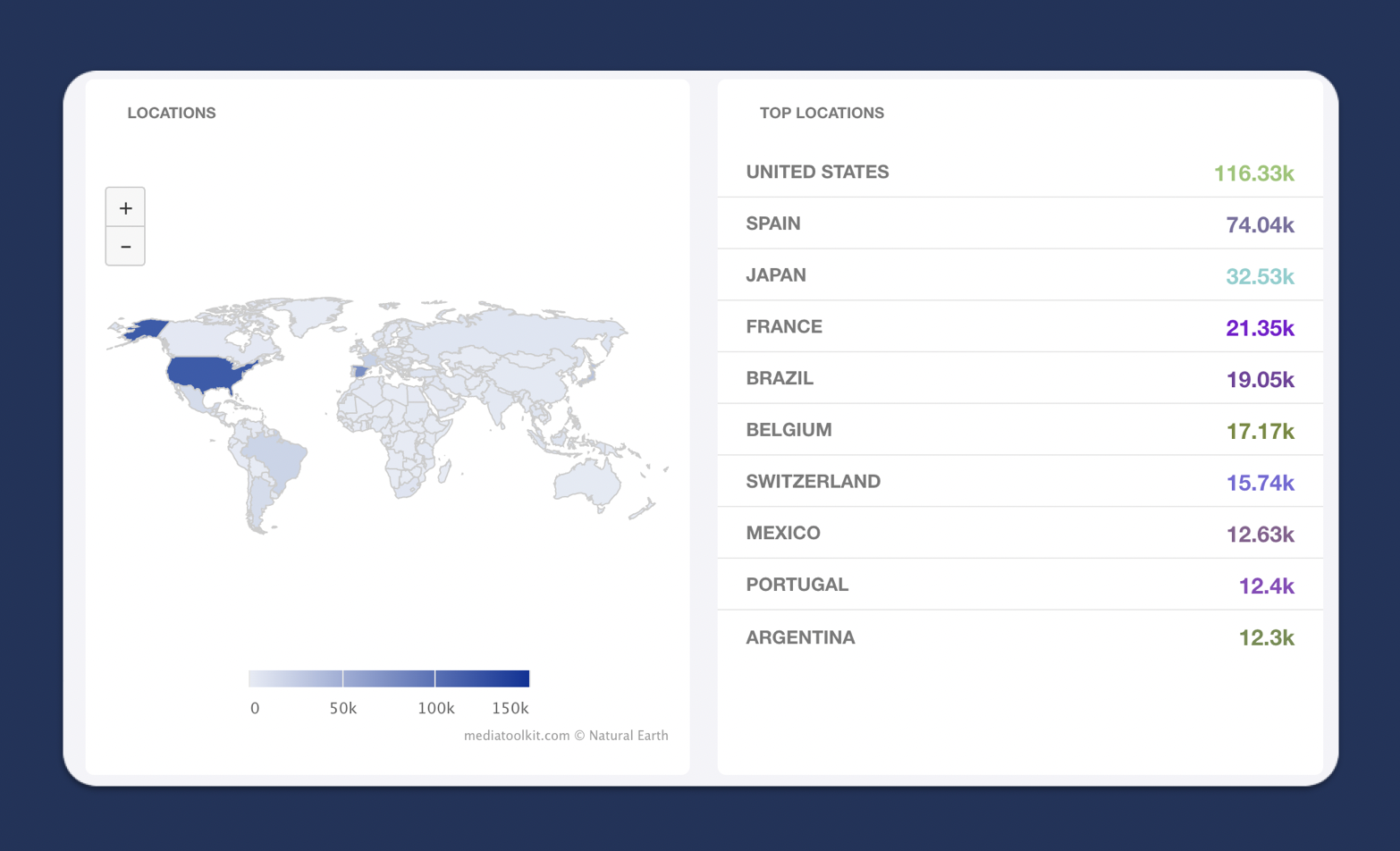
Once you segment your demographics by these factors, it will be easier to create your personas, which leads us to the next part.
Personas
Define your customer personas:
- What challenges are they facing and how can you resolve them?
- How can you engage with your personas?
If you need additional help defining your personas, media monitoring can help.
This is how Determ’s Customer Success Team Lead, Nikolina, does it for our clients:
I will explain how we do it for our clients and how you can do it, too. Let’s keep going with the Nike example. When launching new shoes for running, you already have an idea of the ideal persona. By listing keywords relevant to your topic, you can find the right target groups online and point your marketing efforts towards them.
For instance, the keywords you can track for Nike, and specifically running shoes, could be: outdoor, training, running, comfortable, shoe, long-distance, fast, short distance, fit, etc.
This kind of query setup will help you narrow down the search and point you to the sources that mention these words online the most. With this action, you can get a much clearer image of your target persona.
How they communicate, where they communicate (what channels do they use), what are their most frequent questions, complaints, or needs. A Determ’s report dashboard offers many different insights via many different charts: from sentiment analysis and mentions by channels to top mentions by reach and top influencers (sources or mentions that had the most reach and/or influence).
Additionally, we also advise our clients to use Boolean operators. In this case, you are not just searching for a particular keyword, but also the context that it comes in, which gives you more precise results in the end.
Key current clients
Focus on the current relationship you have with your clients. Which require most focus and how can you expand on those relationships?
Key target clients
Define what type of clients you want to acquire in the future. Focus on the key people or organizations that are relevant to your goals. How can you find, reach, and engage with them?
MEDIA MONITORING ADVICE
By tracking key people of interest through a media monitoring tool, you can discover a lot about them and use it as leverage when approaching them. Just as same as you would track your own brand name or industry topics, you can do the same for the potential clients.
You can see what kind of content they post, what is the sentiment around them in public, what channels are they using most. All of these facts are important when it comes to creating a pitch and tailoring it to them by addressing their pain points and ways you can help them solve their problems.
Key messages
What are the key messages we want to communicate to your target audience? How do the messages differ for specific audience segments? Do these key messages resonate with your organization and the value it provides?
Focus on the public image and if what you want to communicate to the public is really perceived that way on your client’s end.
Channels
What media do your audiences and target customers use? Which channels could you use to engage with them? What channels have been successful for you in the past? Are there any new channels you could use to connect further?
These are all the questions you have to know the answer to in order to effectively plan your communications strategy.
MEDIA MONITORING ADVICE
Here’s how you can discover what channels your audience uses most. Here’s another Nike example. When tracking Nike’s brand name, you can see which users and media outlets are using what channels and what is their reach. It gives you the opportunity to detect the most influential sources to use and engage with. This can save you time and immediately point you in the right direction.
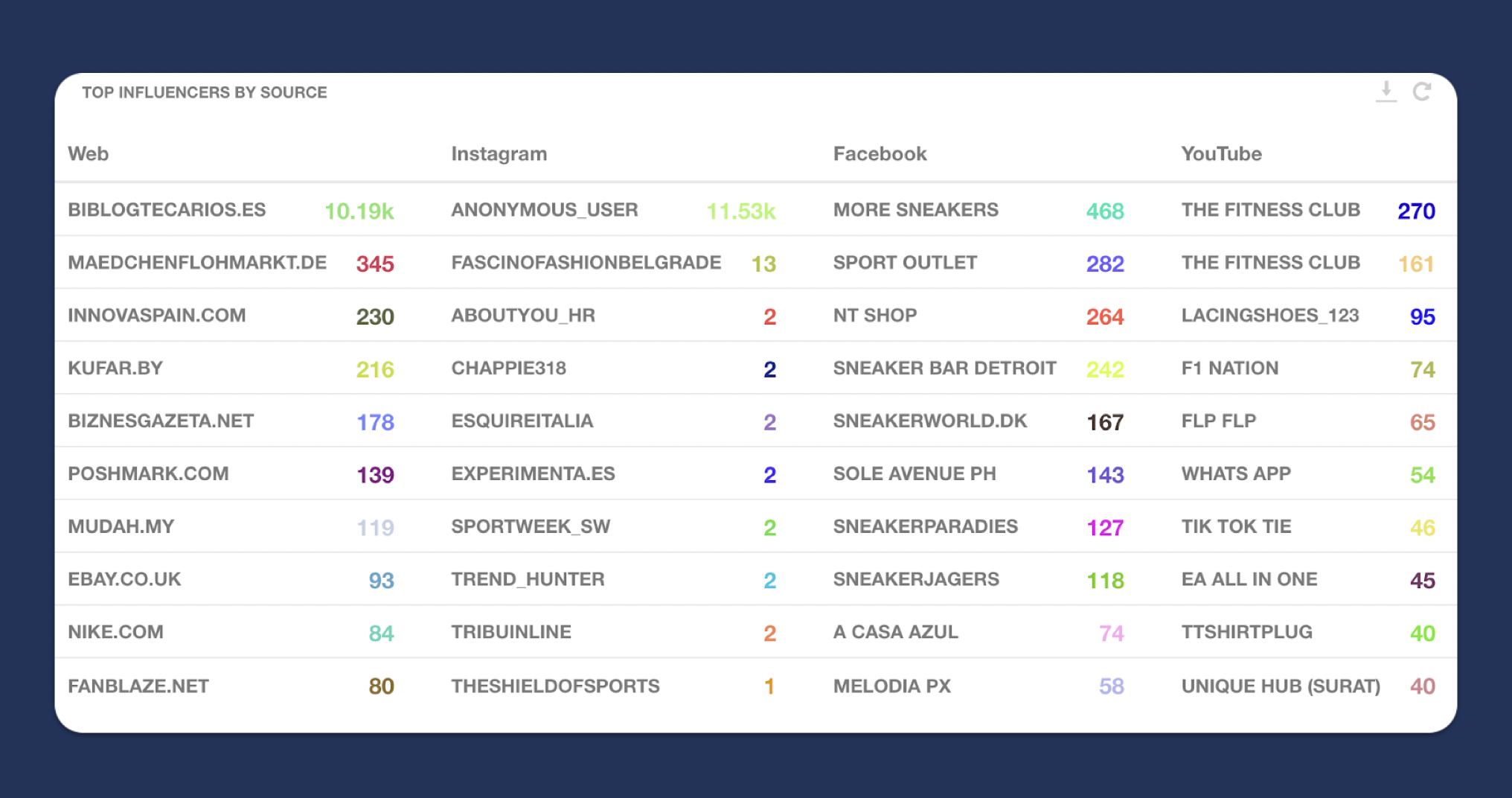
Strategic framework
Strategic framework focuses on what you want to accomplish for that year and how can communications help you achieve your goals. This means defining your OKRs, KPIs and tactics that will help you reach the objectives you’ve set for yourself. All your objectives should be precisely measurable, so you can evaluate their true impact.
Objectives & key results (OKRs)
OKRs are a strategic framework designed to guide an organization towards its goals and targets. You need to take into account:
- What communications objectives can best reflect and help accomplish your organizational goals?
- For each of your objectives, what activities do you need to undertake to reach the goal?
Here’s an example of an OKR for Nike.
Objective:
Increase the sales of Nike running shoes by 50% by the end of 2022.
Key results are the steps you have to take to achieve this objective:
- Find 10 new influencers and start new collaborations.
- Decrease the cost of manufacturing by 10%.
- Make 1 commercial with Michael Jordan.
Key performance indicators (KPIs)
KPIs can help you track the performance of each objective.
In Nike’s example, you can consider KPIs as metrics that you should track. They’re there to keep you on track when it comes to achieving your OKRs.
So, in this case KPIs could be: the number of influencers, reach they have on the online media sites and on social media, etc.
Tactics
What tactics must you complete for each activity (KPI)? What past tactics have proven successful? Can we make them even more effective?
Potential impact matrix
Potential impact matrix helps you identify which objectives could have the greatest impact on your organizational goals by identifying which objectives are the most profitable and which best benefit from your communication efforts.
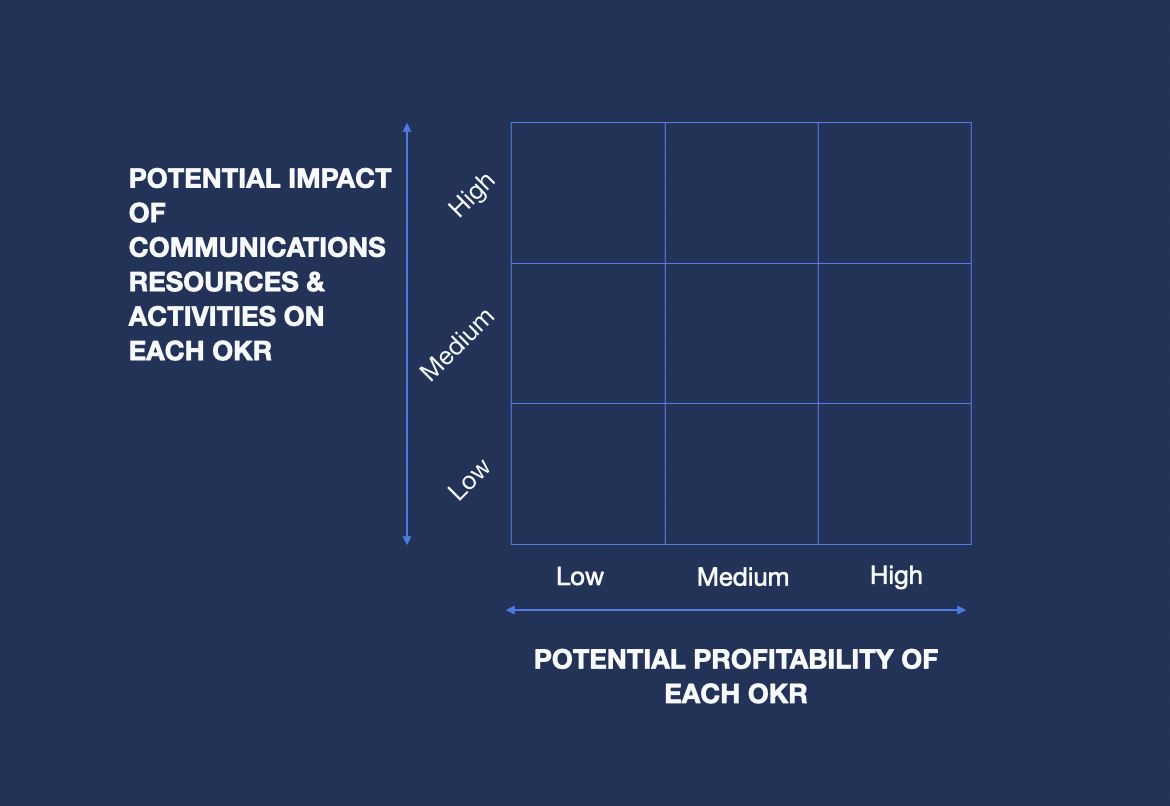
You can start off by making a list of all the potential objectives and placing them on the horizontal axis according to the level of their financial impact. Then, do the same for your communications along the vertical axis. Once you have a clear picture of the most high-impact combination, you can easily decide which communications activities are the most important.
With this impact matrix we covered all of the key elements in the annual communications plan.
Conclusion
Once you’ve created the annual communications plan, the real work starts. What is crucial here is to diligently check in with your plan month after month to see if you’re on the right track.
Having the ability to benchmark monthly, quarterly, and yearly reports will empower you to base your business decisions on relevant and accurate information. Such historical data enables you to go back to a certain event or post and link it to current events at any point in time and thus get a full picture of any matter that might affect your business.
Only thing left to do now is to download the template and start working on your communications plan!
The template covers all the topics we’ve covered in this blog and will further guide you through creating the plan.
Template download
This Annual Communications Plan template has all the elements we’ve covered in this blog, along with some additional guiding help. Download it below!



